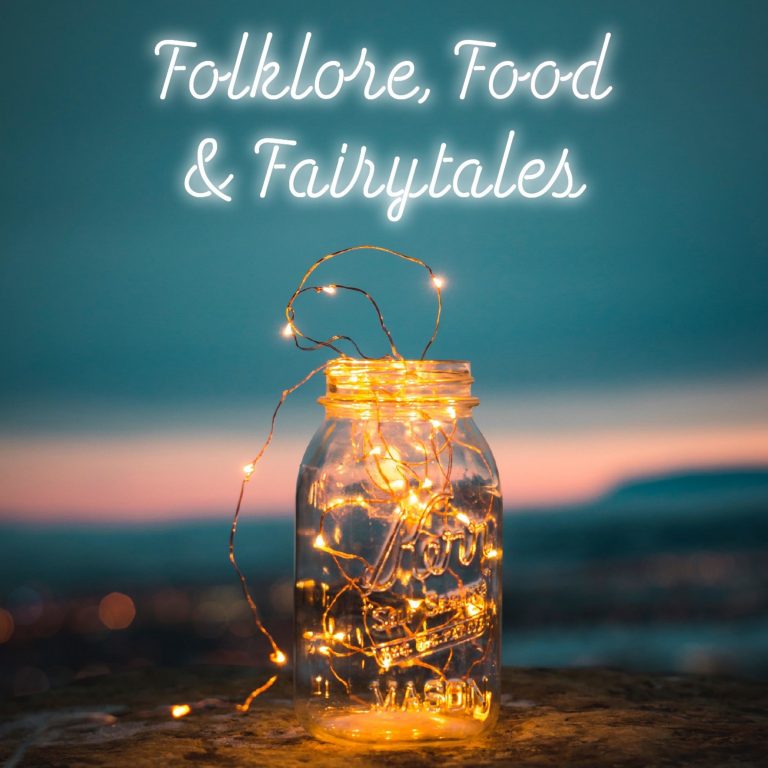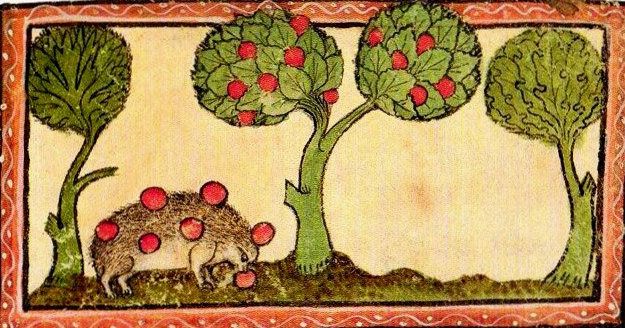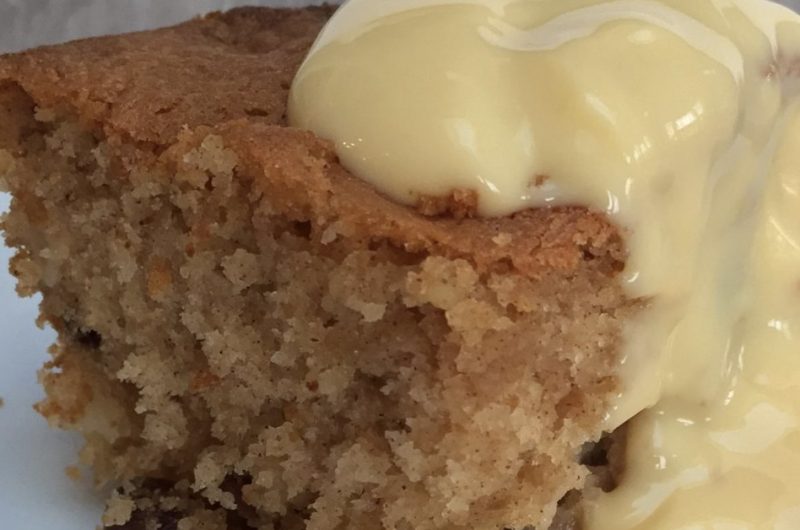In which we discover that golden apples are never in convenient places, that it takes persistence to overcome the odds and that turning up with a large army is a very effective rescue strategy. We also find yet again that brothers can be jealous, that kindness & courtesy never go amiss and chopping things with swords can have surprising results.
In which we discover golden apples are never in convenient places, it takes persistence to overcome the odds and that turning up with a large army is a very effective rescue strategy. We also find yet again that brothers can be jealous, that kindness & courtesy never go amiss and that chopping things with swords can have surprising results.
The episode story is the King of England and His Three Sons as collected by Joseph Jacobs in More English Fairy Tales
The recipe for this episode is Apple Cake
If you would like to know a bit more about some of the links and books I used to research this episode you can find them at Further Reading.
The website that I mentioned is Romani Cultural Arts Company
You can also find out more at Hestia’s Kitchen which has all past episodes and the connected recipes on the blog. If you’d like to get in touch about the podcast you can find me on Twitter or Instagram at @FairyTalesFood.

A Romani Fairytale
So what did you think of this tale? The source of this tale is a Romani fairy tale collected by Joseph Jacobs in More English Fairy Tales. He listed as his source Francis Hindes Groome’s In Gypsy Tents, where the informant was John Roberts, a Welsh Roma. The tale told ‘In Gypsy Tents’ includes more involvement from the Roma clans and indeed the old men who help Jack in the story are also said to be Roma. Jack also spends time with the Roma families after he is sentenced to death by his father after his brothers have betrayed him and that is where he learns his skills on the Welsh harp.
Although Joseph Jacobs credits the Roma history here, he does remove most of the references to Roma and Roma families in the tale itself. There is also another version in Ruth Manning-Sanders collection The Red King and the Witch but sadly I wasn’t able to track down a copy in time to compare it.
Fairytales Never Change
This is yet another Jack tale but it does have some other fairytale elements, the betrayal of the youngest prince by his feckless elder brothers as well as the assistance received from three stranger brothers in his task. There are some similarities to the jealous brothers in the Golden Castle that Floated in the Air in that the sleeping princess comes to find her new beloved after he has been betrayed by his brothers.
This princess also has an army which can hold the country to ransom and is not fooled by the pretences of Jack’s elder brothers. She doesn’t have a child this version but does in the In Gypsy Tents tale. There is a touch of the original Sleeping Beauty tale here where the princess becomes pregnant whilst under an enchanted sleep and bears a child. There is too much to unpack in that version here but suffice it to say that its quite problematic.
An Apple-Based Quest
This tale differs from the Golden Castle significantly in that the princess is an added extra for Jack to win. The quest to find the golden apples is the main story here and the men who help Jack on his way are more focused on that. Although I will take another side trip to look at the request from Jack’s helpers to cut off their heads so they can regain their youth and riches. This is slightly unusual because this is often the fate of magically enchanted animal helpers rather than supposed humans. Jack doesn’t seem to put up much of a fight.
Get Your Golden Apples Here
We should probably take a closer look at the golden apples as they are the focus of the quest. Apples are a significant item in folklore, myth and legend across the world, definitely not limited to the British Isles. They are possibly the symbol of knowledge in the Garden of Eden. I say possibly because many scholars now agree that the fruit is much more likely to have been either figs or pomegranates.
Apples wont grow well in the area that the Garden of Eden was supposed to be located. They are the symbol of youth to the Norse pantheon in the form of Idunn’s apples that keep them youthful. In fact when Idunn is kidnapped from Asgard all the gods age very quickly. The apples of the Hesperides in Greece fulfil a similar function in that they grant the gift of immortality.
A Celtic Tale
They were particularly important to the myths of the Celts with numerous heroes being carried off by otherworldly women as they slept under apple trees. Gods and Goddesses from Tír na nÓg (Land of Youth) were often depicted carrying an apple branch with golden apples and tinkling leaves so musical that it lulled humans to sleep when they heard it.
Emain Ablach( Isle of Apples) is said to be an island paradise where apples grow at the same time as apple blossoms bloom. It is also the the home of Manannán mac Lir, the Irish sea-god and King of the Otherworld. The magical silver apple branch given to Bran in The Voyage of Bran is also said to come from Emain Ablach.
Avalon or Aviemore?
Golden apples of immortality also appear in Avalon where King Arthur was taken after he was fatally wounded din his last battle according to Thomas Mallory’s fifteenth century tale of Arthur & Camelot. The name Avalon comes from the Celtic prefix av or af which means apple. There are at least 46 British place names that have some connection to apples including Avon, Aviemore, Appledore and Applesham which demonstrates the importance of them to Celts and Anglo-Saxons.
There is one caveat in all this, in Middle English as late as the 17th century, the word ‘apple’ was used as a generic term to describe all fruit other than berries, so the appearance of apples in ancient writings may not actually be the apples known today. Apples in the British Isles were crab apples rather than the juicy, sweet apples we think of today.
Father of Apples
It is believed they came over with the Romans but that they originated in the area around Almaty in Kazakhstan. The name of the city even translates as Father of Apples. I could also explain that the way we consistently get certain types of apples through a technique known as grafting. I could but I won’t because I don’t entirely understand it so I think I’ll refer to it as apple magic. Just like the ceremony of wassailing or in divination (mostly for husbands).
Apples became important to the Romans because they were important to the ancient Greeks. They became important to the Greeks because Alexander the Great became enamoured of them due to his exposure to them as part of Persian culture. Although we got apples from the Romans, after the Roman Empire fell and the British Isles returned to more local government it was probably only the monasteries who kept our apple varieties alive. The battles that took place in the power vacuum after the Romans left did not show any respect for agriculture generally or apple orchards in particular.
Some Fish with Your Apples?
We should probably look at some recipes, like most fruits there was some concern about eating them uncooked and a lot of apples were used to make cider as like ale it purified the water due to the alcohol to some extent and unlike ale did not use a lot of fuel. Some of the early tart recipes have some interesting combinations such as apples, pears, raisins, figs and then totally unexpected to our modern palate, salmon or haddock.
Some are more recognisable, however. MS Douce 257 is a English manuscript containing recipes from 1381 and has a recipe for Apple tart which contains cooked down apples with dried fruit, pears, spices and saffron in a pastry case (a very hard, inedible pastry case but still). This is very similar to a recipe in Forme of Cury from 1390 so even the King was enjoying a nice apple tart in medieval days.
How Do You Like Your Pie?
I’m going to surprise you by not entering into the cheese and apple pie discussion even though I really want to question the person that thought the tradition came from the English tradition of serving apple pie with custard. I’ll spare you the rest of my thoughts, they’re not very polite. I must also admit that I’m not a fan of apple pie or even crumble. I’d much rather have rhubarb or gooseberry crumble any day.
Apple is also a fantastic accompaniment to pork but I don’t really eat much pork although I do enjoy a pork and apple sausage. I am very happy with an apple based chutney too. I think though that we’ll do apple cake because its nice and a great alternative to crumble. It uses Bramley cooking apples so its not overly sweet and is more of a Dorset apple cake rather than a German apple cake.
Apple Cake
6-8
servings30
minutes1
hour20
minutesIngredients
225g butter, softened, plus extra for greasing
450g Bramley apples
Finely grated zest and juice of 1 lemon
225g caster sugar, plus extra for dredging
3 large eggs
225g self-raising flour
2 tsp baking powder
25g ground almonds
1/2 tsp cinnamon
1 tbsp demerara sugar
Directions
- Preheat the oven to 180°C/fan160°C/gas 4. Grease a deep 23-24cm springform cake tin and line with baking paper. Peel, core and cut the apples into 1cm pieces, and toss with the lemon juice.
- Using an electric hand whisk, cream together the butter, caster sugar and lemon zest in a bowl until pale and fluffy. Beat in the eggs, 1 at a time, adding a little flour with each addition to keep the mixture smooth.
- Sift the remaining flour and the baking powder into the bowl and fold in with the ground almonds. Drain the apple pieces well, then stir into the mixture.
- Spoon into the prepared cake tin, lightly level the top and sprinkle with the demerara sugar. Bake in the oven for 1 hour or until well-risen, brown and a skewer inserted into the centre of the cake comes out clean. If the cake starts to look a little too brown, cover with a sheet of baking paper after about 45 minutes.
- Leave to cool in the tin for 20 minutes. Remove the cake from the tin and place on a serving plate. Dredge heavily with the extra caster sugar. Cut the cake into generous wedges and serve warm with a spoonful of clotted cream or custard.
Further Reading
More English Fairy Tales – Joseph Jacobs
In Gypsy Tents Francis Hindes Groome
Apple, A Global History – Erika Janik
Romani Cultural Arts Company
https://hestiaskitchen.co.uk/2021/03/30/the-golden-castle/
https://en.wikipedia.org/wiki/The_King_of_England_and_his_Three_Sons
https://www.gutenberg.org/ebooks/8102
http://medievalcookery.com/etexts/doucems257.html


